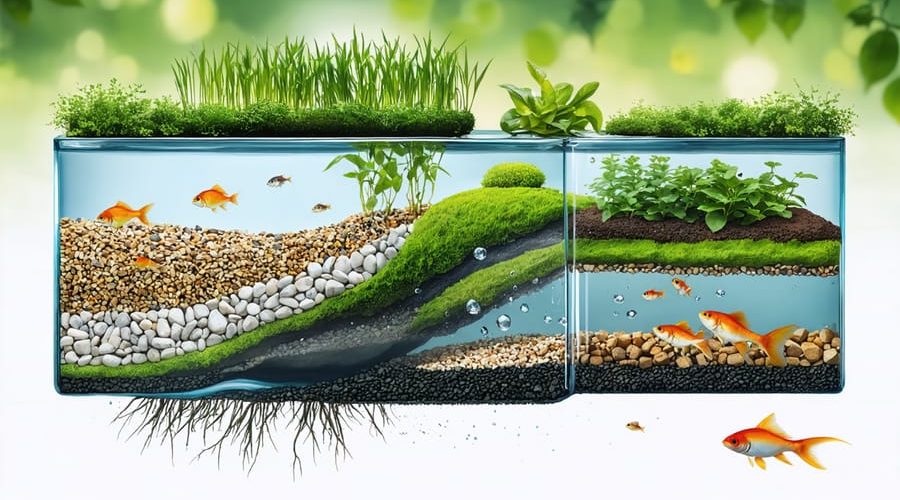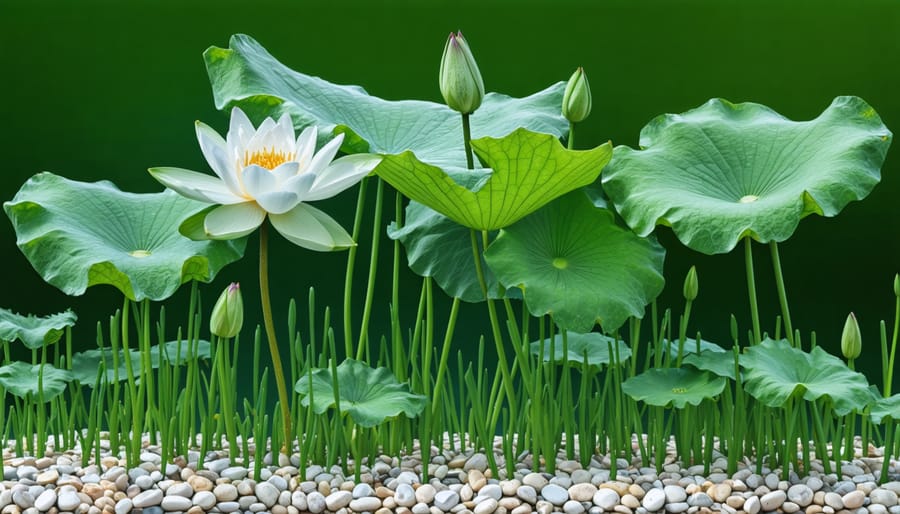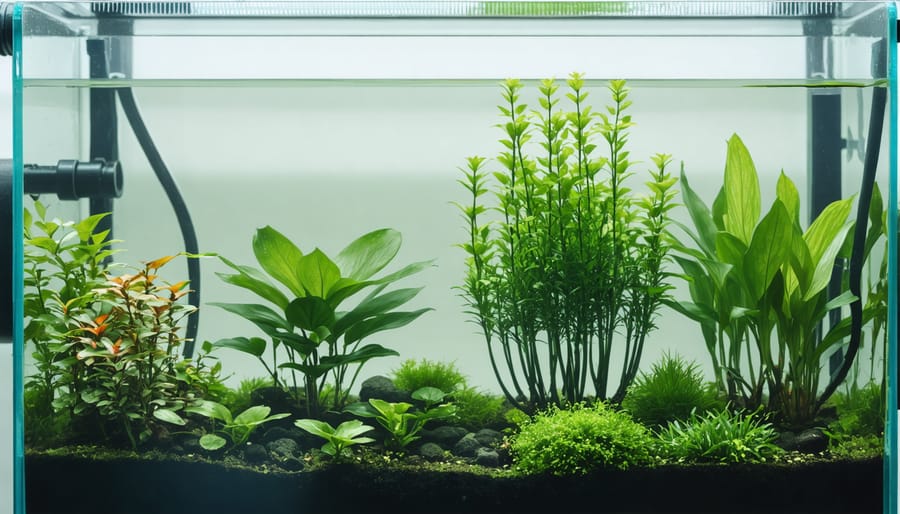
Perfect Plant Media for Your Pond: Creating a Thriving Water Garden Ecosystem
Choose pond plant media based on your specific aquatic plants – pea gravel works best for marginal plants, while water lilies thrive in heavy clay loam. Create layers in planting baskets using larger stones at the bottom for stability and finer media on top to prevent soil washout. Mix organic and inorganic materials in a 70:30 ratio to establish a balanced pond ecosystem that supports both plant growth and beneficial bacteria. Top your media with a 1-inch layer of pebbles or river rock to keep fish from disturbing the planting medium while allowing roots to establish naturally.
The right growing medium serves as more than just an anchor – it provides essential nutrients, promotes healthy root development, and helps maintain water clarity. Select materials that won’t alter water chemistry, avoiding limestone-based products that can increase pH levels. Consider expanded clay pellets for their excellent drainage properties and reusability, making them ideal for both novice and experienced water gardeners.
Understanding Pond Plant Media Basics
What Makes Good Plant Media?
Good pond plant media needs to strike the perfect balance between several key characteristics. First, it should be heavy enough to anchor your plants securely, preventing them from floating away or tipping over. Clay-based materials and natural gravels work well for this purpose.
The media must also provide adequate nutrients while maintaining good drainage. Look for materials that won’t break down quickly in water, as decomposing media can cloud your pond and affect water quality. The best options have a mix of particle sizes, allowing roots to spread easily while trapping enough nutrients for healthy growth.
Equally important is the media’s ability to maintain a stable pH level. Avoid materials that could alter your pond’s water chemistry, such as limestone-based products that might increase alkalinity. The ideal media should also be free from harmful chemicals and pollutants that could harm your fish or encourage algae growth.
For best results, choose media that’s specifically designed for aquatic plants or mix your own using pond-safe components like aquatic soil and small gravel. This ensures your plants have the perfect foundation to thrive while keeping your pond ecosystem balanced and healthy.

Popular Types of Pond Plant Media
Aquatic Soil and Clay-Based Media
Traditional aquatic soil substrates and clay-based media are time-tested favorites among pond enthusiasts. These natural materials closely mimic the bottom of natural ponds, providing an ideal environment for root development and nutrient uptake. Heavy clay loam, which contains a mix of clay and organic matter, offers excellent nutrient retention while remaining firm enough to anchor plants securely.
Garden loam mixed with clay is another popular option, providing good water retention and stability. When using these traditional media, aim for a mixture that holds its shape when squeezed but doesn’t become too compact. A good rule of thumb is to use about 70% clay to 30% loam for most aquatic plants.
For best results, avoid using regular garden soil, as it can cloud your pond water and potentially release harmful nutrients. Instead, look for specially formulated aquatic planting media available at garden centers, which often combine clay with beneficial minerals and nutrients specifically balanced for pond plants.
Gravel and Stone Options
Different plants thrive in different types of gravel and stone media. For shallow-rooted floating plants, pea gravel (1/4 to 3/8 inch) works wonderfully and looks natural in your pond. Medium-sized gravel (1/2 to 3/4 inch) is perfect for most marginal plants and provides excellent stability for their root systems.
For deep-rooted plants like water lilies, larger river rocks (1 to 2 inches) create ideal spaces between stones for roots to spread while anchoring plants securely. Avoid using limestone or other minerals that can affect water chemistry. Instead, opt for inert materials like granite or quartz-based gravels.
When choosing your gravel, make sure it’s thoroughly washed and free from dirt. A mix of sizes can create a more natural look and provide various anchor points for different plant types. For the best results, layer your gravel with larger stones at the bottom of containers and finer gravel on top to prevent soil from floating up while allowing roots to grow freely.

Alternative Media Choices
Modern pond gardening has introduced exciting alternatives to traditional growing media. Expanded clay pellets, also known as LECA (Lightweight Expanded Clay Aggregate), have become increasingly popular due to their excellent drainage and reusability. These round, porous balls provide strong root support while maintaining ideal moisture levels for aquatic plants.
Specialized aquatic plant mixes now combine various materials like volcanic rock, zeolite, and coconut coir. These custom blends offer superior nutrient retention and create an ideal environment for beneficial bacteria. Some mixes even include activated carbon to help maintain water clarity and reduce excess nutrients.
Synthetic foam-based media has also gained traction, particularly for floating gardens and vertical pond installations. These lightweight options are excellent for smaller ponds and container water gardens where weight is a concern.
Bio-based alternatives like rice hulls and compressed bamboo are emerging as eco-friendly choices. They’re renewable, biodegradable, and provide excellent aeration for plant roots. While these newer options might cost more initially, their longevity and environmental benefits make them worth considering for the conscious pond gardener.
How Plant Media Supports Fish Health
The relationship between plant media and fish health in your pond is truly remarkable. Plant media doesn’t just support plant growth – it creates a complex ecosystem that directly benefits your finned friends. As your plants establish themselves in quality media, their roots develop extensive networks that act as natural filters, removing excess nutrients and pollutants from the water.
Think of plant media as a high-rise apartment building for beneficial bacteria. These microscopic helpers break down fish waste and other organic matter, converting them into nutrients that plants that support fish health can use. This natural filtration process helps maintain clearer water and more stable water chemistry, creating a healthier environment for your fish.
The right plant media also provides shelter for small aquatic creatures like freshwater shrimp and snails, which help maintain pond cleanliness. As plants grow and establish themselves in the media, their leaves offer shade and hiding spots for fish, reducing stress and creating natural territories. This is especially important during hot summer months when fish need cooling shelter.
Additionally, plant media helps prevent excessive nutrients from building up in your pond water. When plants are properly anchored in quality media, they’re better able to absorb these nutrients, reducing the likelihood of algal blooms that can deplete oxygen levels and harm fish. The media’s texture and composition also trap floating particles, further improving water clarity and making it easier for fish to breathe and navigate their environment.
Remember, healthy plants mean healthy fish, and it all starts with choosing the right media for your pond plants.
Choosing and Using the Right Media
Media for Different Plant Types
Different pond plants thrive in specific types of media. For floating plants like water lilies and lotus, use heavy clay-based soil mixed with aquatic planting media. These plants need nutrient-rich, dense material to anchor their substantial root systems and support heavy blooms.
Marginal plants, including rushes and iris, do well in a mixture of garden soil and gravel. This combination provides stability while allowing roots to spread naturally. Shallow-water plants like water forget-me-nots prefer a lighter mix of aquatic soil and fine gravel to prevent compaction.
For submerged oxygenating plants such as hornwort, use plain gravel or small pebbles. These plants absorb nutrients directly from the water, so they don’t need nutrient-rich media. When planting bog plants around your pond’s edge, use a mix of peat moss and aquatic soil to maintain moisture while providing good drainage.
Remember to top all planted containers with a layer of gravel to prevent soil from clouding your pond water.

Installation and Maintenance Tips
Begin by preparing your planting containers with drainage holes to prevent soil compaction. Fill containers about two-thirds full with your chosen media, ensuring it’s pre-rinsed to remove any dust or debris. When planting, position your aquatic plant at the proper depth, then add media around the roots while gently tamping down to eliminate air pockets.
For maintenance, check media levels monthly during the growing season, as it can settle or be displaced by fish activity. Top up as needed, but avoid overfilling containers. Every spring, gently remove the top layer of media and replace it with fresh material to prevent nutrient depletion.
Watch for signs that media needs complete replacement, such as breaking down into mush or developing an unpleasant odor. Most pond plant media lasts 2-3 years before requiring full replacement. When replacing, save some of the old media to mix with the new, helping beneficial bacteria colonies establish quickly.
Clean your media by swishing it in pond water rather than tap water to preserve beneficial microorganisms. During winter, leave media in place to protect dormant plant roots.
Creating the perfect pond ecosystem is within your reach with the right plant media choices. Whether you opt for aquatic soil, expanded clay, or gravel, remember that each medium serves a unique purpose in supporting your pond plants and maintaining water quality. By carefully selecting and layering your plant media, you’ll create an environment where both plants and fish can thrive. Don’t be afraid to experiment with different combinations to find what works best for your specific needs and pond conditions. Start small, observe how your plants respond, and adjust as needed. With proper planning and maintenance, your pond will become a thriving sanctuary that brings beauty and tranquility to your outdoor space for years to come.
